Chernihiv
Чернігів | |
|---|---|
   .jpg.webp)   From top, left to right: Trinity Monastery, Chernihiv Philharmony, Administrative building, The building of the former provincial zemstvo, Piatnytska Church, and view of ancient Chernihiv with Transfiguration, Boris and Gleb Cathedrals and Chernihiv Collegium | |
 Flag  Coat of arms  | |
| Nickname: City of Legends | |
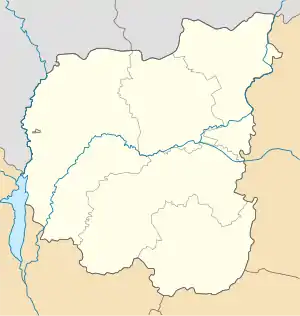 Chernihiv Location of Chernihiv in Ukraine  Chernihiv Chernihiv (Ukraine) | |
| Coordinates: 51°29′38″N 31°17′41″E / 51.49389°N 31.29472°E | |
| Country | |
| Oblast | Chernihiv Oblast |
| Raion | Chernihiv Raion |
| Hromada | Chernihiv urban hromada |
| First mentioned | 907 |
| Government | |
| • Mayor | Oleksandr Lomako[1] (Native Home[2]) |
| Area | |
| • Total | 79 km2 (31 sq mi) |
| Elevation | 136 m (446 ft) |
| Population (2022) | |
| • Total | 282,747 |
| • Density | 1,547/km2 (4,010/sq mi) |
| Postal code | 14000 |
| Area code | (+380) 462 |
| Vehicle registration | CB / 25 |
| Website | chernigiv-rada.gov.ua |
Chernihiv (Ukrainian: Чернігів, IPA: [tʃerˈn⁽ʲ⁾iɦiu̯] ⓘ), formerly also known as Chernigov[lower-alpha 1] is a city and municipality in northern Ukraine, which serves as the administrative center of Chernihiv Oblast and Chernihiv Raion within the oblast.[3] Chernihiv's population is 282,747 (2022 estimate).[4]
The city was designated as a Hero City of Ukraine by the Ukrainian government during the 2022 Russian invasion of Ukraine.[5]
History
Etymology
The name "Chernihiv" is a compound name, which begins with the root 'Cherni/Cherno,' which means "black" in Slavic.[6] Scholars vary with interpretations of the second part of the name ("hiv"/gov", "говъ") though scholars such as Dr. Martin Dimnik, Professor of Medieval History at University of Toronto, connect Chernihov with the worship of "the black god" Chernibog.[7]
Early history
Chernihiv was first mentioned (as Черниговъ) in the Rus'–Byzantine Treaty (907), but the time of its establishment is unknown.[8] Artifacts from the Khazar Khaganate uncovered by archaeological excavations at a settlement there indicate that it seems to have existed at least as early as the 9th century. Towards the end of the 10th century, the city probably had its own rulers. It was there that the Black Grave, one of the largest and earliest royal mounds in Eastern Europe, was excavated in the 19th century.
The city was the second wealthiest and most important in the southern portion of the Kievan Rus'.[9] From the early 11th century on, it was the seat of the powerful Principality of Chernigov, whose rulers at times vied for power with Kievan Grand Princes, and often overthrew them and took the primary seat in Kiev for themselves.
The grand principality was the largest in Kievan Rus and included not only the Severian towns but even such remote regions as Murom, Ryazan and Tmutarakan. The golden age of Chernigov, when the city population peaked at 25,000, lasted until 1239 when the city was sacked by the hordes of Batu Khan, and entered a long period of relative obscurity.
The area fell under the Grand Duchy of Lithuania in 1353. The city was burned again by Crimean khan Meñli I Giray in 1482 and 1497 and in the 15th to 17th centuries changed hands several times between Lithuania, Muscovy (1408–1420 and from 1503), and the Polish-Lithuanian Commonwealth (1618–1648), where it was granted Magdeburg rights in 1623 and in 1635 became a seat of Chernihiv Voivodeship in the Lesser Poland Province.
The area's importance increased again in the middle of the 17th century during and after the Khmelnytsky Uprising. In the Hetman State Chernihiv was the city of deployment of Chernihiv Cossack regiment (both a military and territorial unit of the time).
Imperial Russia
Under the 1667 Treaty of Andrusovo the legal suzerainty of the area was ceded to the Tsardom of Russia, with Chernihiv remaining an important center of the autonomous Cossack Hetmanate. With the abolishment of the Hetmanate, the city became an ordinary administrative center of the Russian Empire and a capital of local administrative units. The area in general was ruled by the Governor-General appointed from Saint Petersburg, the imperial capital, and Chernihiv was the capital of local namestnichestvo (province) (from 1782), Malorosiyskaya or Little Russian (from 1797) and Chernigov Governorate (from 1808).
According to the census of 1897, the city of Chernihiv had 11,000 Jews out of a total population of 27,006. Their primary occupations were industrial and commercial. Many tobacco plantations and fruit gardens in the neighborhood were owned by Jews. There were 1,321 Jewish artisans in Chernihiv, including 404 tailors and seamstresses, but the demand for artisan labor was limited to the town. There were 69 Jewish day-laborers, almost exclusively teamsters. Few, however, were employed in factories.[10][11]
World War II
During World War II, Chernihiv was occupied by the German Army from 9 September 1941 to 21 September 1943. The Germans operated a Nazi prison[12] and a forced labour battalion for Jews in the city.[13]
Recent history
The Statue of Lenin on Myru Avenue was toppled on February 21, 2014, as part of the demolitions of the statues of Lenin in Ukraine.[14][15]
Until 18 July 2020, Chernihiv was designated as a city of oblast significance and did not belong to Chernihiv Raion even though it was the center of the raion. As part of the administrative reform of Ukraine, which reduced the number of raions of Chernihiv Oblast to five, the city was merged into Chernihiv Raion.[16][17]
In June 2022, Chernihiv signed an agreement with Rzeszów, Poland to become sister cities.[18][19]
Siege of Chernihiv
.jpg.webp)
On 24 February 2022, during the 2022 Russian invasion of Ukraine, the city was under siege by the Russian Armed Forces according to the Russian Ministry of Defense,[20] in its first battle since the Second World War. On 10 March 2022, Mayor Vladyslav Atroshenko announced that the city had been completely encircled by Russian forces.[21]
On 5 April 2022, Governor of Chernihiv Oblast Vyacheslav Chaus stated that the Russian military has left Chernihiv Oblast, but that it had planted mines in many areas.[22][23][24]
On 19 August 2023, a Russian missile strike killed seven in the city.
Demographics
| 1897 | 1926 | 1939 | 1959 | 1970 | 1979 | 1989 | 2001 | 2017 | 2022 |
|---|---|---|---|---|---|---|---|---|---|
| 27 716 | 34 359 | 68 597 | 89 585 | 158 873 | 238 141 | 296 347 | 304 994 | 291 641 | 282 747 |
Language
Distribution of the population by native language according to the 2001 census:[25]
| Language | Percentage |
|---|---|
| Ukrainian | 74.01% |
| Russian | 24.5% |
| other/undecided | 1.49% |
According to a survey conducted by the International Republican Institute between April and May 2023, 53% of the city's population spoke Ukrainian at home, and 41% spoke Russian.[26]
Geography
Chernihiv stands on the Desna River 150 km (93 mi) to the north-northeast of Kyiv.
The area was served by Chernihiv Shestovytsia Airport prior to 2002, and during the Cold War it was the site of Chernihiv air base.
Rivers
Desna River
The city of Chernihiv is crossed by Desna River, a major left tributary of the Dnieper River. "Desna" means "right hand" in the Old East Slavic language. It is 1,130 km (700 mi) long, and has a drainage basin that covers 88,900 km2 (34,300 sq mi).
In Ukraine, the river's width ranges from 60 to 250 m (200 to 820 ft), with its average depth being 3 m (9.8 ft). The mean annual discharge at its mouth is 360 m3/s (13,000 cu ft/s). The river freezes over from early December to early April and is navigable from Novhorod-Siverskyi to its mouth, for about 535 km (332 mi).
Snov River
The Snov River, right tributary of the Desna River (Dnieper basin), also goes through Chernihiv. The length of the river is 253 km (157 mi). The area of its drainage basin is 8,700 km2 (3,400 sq mi). The Snov freezes in November – late January and stays icebound until March – early April. Part of the river forms the Russia–Ukraine border.
According to Ruthenian chronicles, in 1068 a battle took place at the Snov River between Duke of Chernihiv Sviatoslav Yaroslavich and Cumans led by Duke Sharukan.
Climate
Chernihiv has a humid continental climate (Köppen Dfb) with cold, cloudy and snowy winters, and warm, sunny summers. The average annual temperature for Chernihiv is 7.0 °C (44.6 °F), ranging from a low of −5.6 °C (21.9 °F) in January to a high of 19.5 °C (67.1 °F) in July. Precipitation is well distributed throughout the year though precipitation is higher during the summer months and lower during the winter months. The record high was 41.1 °C (106.0 °F) and the record low was −36.0 °C (−32.8 °F).
| Climate data for Chernihiv (1991–2020, extremes 1948–present) | |||||||||||||
|---|---|---|---|---|---|---|---|---|---|---|---|---|---|
| Month | Jan | Feb | Mar | Apr | May | Jun | Jul | Aug | Sep | Oct | Nov | Dec | Year |
| Record high °C (°F) | 9.8 (49.6) |
16.2 (61.2) |
22.3 (72.1) |
29.7 (85.5) |
33.5 (92.3) |
36.0 (96.8) |
41.1 (106.0) |
38.0 (100.4) |
35.5 (95.9) |
27.8 (82.0) |
18.4 (65.1) |
13.1 (55.6) |
41.1 (106.0) |
| Mean daily maximum °C (°F) | −1.7 (28.9) |
−0.2 (31.6) |
5.7 (42.3) |
14.5 (58.1) |
20.8 (69.4) |
24.3 (75.7) |
26.3 (79.3) |
25.6 (78.1) |
19.5 (67.1) |
12.2 (54.0) |
4.3 (39.7) |
−0.4 (31.3) |
12.6 (54.7) |
| Daily mean °C (°F) | −4.2 (24.4) |
−3.4 (25.9) |
1.4 (34.5) |
9.0 (48.2) |
15.0 (59.0) |
18.6 (65.5) |
20.5 (68.9) |
19.3 (66.7) |
13.8 (56.8) |
7.5 (45.5) |
1.7 (35.1) |
−2.7 (27.1) |
8.0 (46.4) |
| Mean daily minimum °C (°F) | −6.6 (20.1) |
−6.3 (20.7) |
−2.3 (27.9) |
3.9 (39.0) |
9.4 (48.9) |
13.0 (55.4) |
15.0 (59.0) |
13.6 (56.5) |
8.8 (47.8) |
3.6 (38.5) |
−0.7 (30.7) |
−4.9 (23.2) |
3.9 (39.0) |
| Record low °C (°F) | −36 (−33) |
−33.9 (−29.0) |
−29.9 (−21.8) |
−13.9 (7.0) |
−3.3 (26.1) |
1.1 (34.0) |
4.6 (40.3) |
2.0 (35.6) |
−4.3 (24.3) |
−10.8 (12.6) |
−23.5 (−10.3) |
−28 (−18) |
−36 (−33) |
| Average precipitation mm (inches) | 33.5 (1.32) |
37.8 (1.49) |
33.7 (1.33) |
41.4 (1.63) |
54.9 (2.16) |
68.0 (2.68) |
71.0 (2.80) |
59.0 (2.32) |
57.1 (2.25) |
42.0 (1.65) |
48.1 (1.89) |
44.7 (1.76) |
591.2 (23.28) |
| Average precipitation days (≥ 1.0 mm) | 9 | 9 | 8 | 6 | 9 | 8 | 9 | 6 | 7 | 8 | 9 | 10 | 98 |
| Average snowy days | 16 | 13 | 8 | 2 | 0 | 0 | 0 | 0 | 0 | 2 | 8 | 15 | 64 |
| Average relative humidity (%) | 85.6 | 82.8 | 77.9 | 68.8 | 66.4 | 70.3 | 70.7 | 70.4 | 77.2 | 81.5 | 87.6 | 87.4 | 77.2 |
| Mean monthly sunshine hours | 46 | 71 | 140 | 197 | 275 | 300 | 300 | 275 | 189 | 120 | 42 | 35 | 1,990 |
| Source 1: Pogoda.ru[27] | |||||||||||||
| Source 2: World Meteorological Organization (humidity 1981–2010, sun 1991-2020),[28] Weatherbase (snow days)[29] [30] | |||||||||||||
Architecture
Chernihiv's architectural monuments chronicle the two most flourishing periods in the city's history – those of Kievan Rus' (11th and 12th centuries) and of the Cossack Hetmanate (late 17th and early 18th centuries).
The oldest church in the city and one of the oldest churches in Ukraine is the 5-domed Transfiguration Cathedral, commissioned in the early 1030s by Mstislav the Bold and completed several decades later by his brother, Yaroslav the Wise. The Cathedral of Sts Boris and Gleb, dating from the mid-12th century, was much rebuilt in succeeding periods, before being restored to its original shape in the 20th century. Likewise built in brick, it has a single dome and six pillars.
The crowning achievement of Chernihiv masters was the exquisite Piatnytska Church, constructed at the turn of the 12th and 13th centuries. This graceful building was seriously damaged in the Second World War; its original medieval outlook was reconstructed to a design by Pyotr Baranovsky.
The historic center of Chernihiv has been on the UNESCO World Heritage Tentative List since 1989,[31] but currently the creation of a renewed nomination is underway.[32][33]
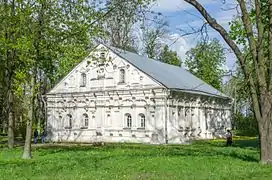
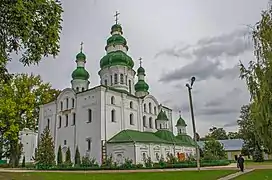 Yeletsky monastery cathedral was modeled after that of Kyiv Pechersk Lavra. Note the contrast between its austere 12th-century walls and baroque 17th-century domes.
Yeletsky monastery cathedral was modeled after that of Kyiv Pechersk Lavra. Note the contrast between its austere 12th-century walls and baroque 17th-century domes.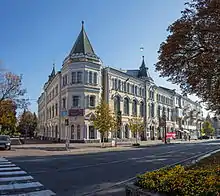
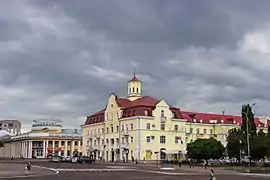 Hotel Desna
Hotel Desna Tarnovsky Museum of Antiquities
Tarnovsky Museum of Antiquities
The earliest residential buildings in the downtown date from the late 17th century, a period when a Cossack regiment was deployed there. Two most representative residences are those of Polkovnyk Lyzohub (1690s) and Polkovnyk Polubotok (18th century). The former mansion, popularly known as the Mazepa House, used to contain the regiment's chancellery. One of the most profusely decorated Cossack structures is undoubtedly the ecclesiastical collegium, surmounted by a bell-tower (1702). The archbishop's residence was constructed nearby in the 1780s. St. Catherine Church (1715), with its 5 gilded pear domes, traditional for Ukrainian architecture, is thought to have been intended as a memorial to the regiment's exploits during the storm of Azov in 1696.
Monasteries
All through the most trying periods of its history, Chernihiv retained its ecclesiastical importance as the seat of either a bishopric or an archbishopric. At the outskirts of the modern city lie two ancient cave monasteries formerly used as the bishops' residences.
The caves of the Yeletskyi Monastery are said to predate those of the Kyiv Pechersk Lavra (Kyiv Monastery of the Caves). Its magnificent six-pillared cathedral was erected at the turn of the 11th to 12th centuries; some traces of its 750-year-old murals may still be seen in the interior. After the domes collapsed in 1611, they were augmented and reconstructed in the Ukrainian baroque style. The wall, monastic cells, and bell-tower all date from the 17th century.
The nearby mother superior's house is thought to be the oldest residential building in the Left-Bank Ukraine. The cloister's holiest icon used to be that of Theotokos, who made her epiphany to Sviatoslav of Chernigov on 6 February 1060. The icon, called Yeletskaya after the fir wood it was painted upon, was taken to Moscow by Svyatoslav's descendants, the Baryatinsky family, in 1579.
 The Savior Transfiguration Cathedral of Chernihiv (1030s) is the oldest in Ukraine.
The Savior Transfiguration Cathedral of Chernihiv (1030s) is the oldest in Ukraine._%D0%B1%D1%96%D0%BB%D1%8F_%D1%84%D0%BE%D0%BD%D1%82%D0%B0%D0%BD%D1%83.jpg.webp) Piatnytska Church of Saint Paraskevi (c. 1201, restored after World War II).
Piatnytska Church of Saint Paraskevi (c. 1201, restored after World War II). Borysohlibskyi Cathedral (1120s)
Borysohlibskyi Cathedral (1120s).jpg.webp) Chernihiv Collegium (1700s)
Chernihiv Collegium (1700s) Catherine's Church (1715s)
Catherine's Church (1715s)
The nearby Chernihiv Glory Memorial we can find Saint Anthony Caves of Saint Elijah and the Holy Trinity features a small eponymous church, built 800 years ago. The roomy Trinity cathedral, one of the most imposing monuments of Cossack baroque, was erected between 1679 and 1689. Its refectory, with the adjoining church of Presentation to the Temple, was finished by 1679. There are also the 17th-century towered walls, monastic cells, and the five-tiered belfry from the 1780s.
Other historic abbeys in the vicinity of Chernihiv include those in Kozelets and Hustynia, which feature superb examples of Ukrainian Baroque.
Economy
Industry
Cheksil, one of the largest enterprises in the Ukrainian textile industry, is based in Chernihiv. The first stage of the plant was put into operation in 1963.[34] The city also has the Chernihiv Musical Instrument Factory established in 1933. In 1995 a manufacturer of goods for animals, called COLLAR Company, was established by Yuri Sinitsa.[35][36][37]
Education
Chernihiv has a Chernihiv National University of Technology, Chernihiv State Technological University and Taras Shevchenko National University "Chernihiv College".
Transport
Train

Chernihiv has a train station with bus station called Chernihiv Ovruch railway. Narrow gauge railway of 76 versts was laid from the Kruty station of the Moscow Kyiv-Voronezh railway towards Chernihiv. In 1893, on the left bank of the Desna River, in the area of a modern automobile bridge, a railway station was built along the Kyiv highway. Passengers were delivered here from the city and back by horse transport.
In 1925, traffic was opened on the Nizhyn to Chernigov section of the Southwest Railway. But rail transport in Chernihiv was postponed until 1928. The bridge over the Desna River was not ready and trains still arrived on the left bank, where the old narrow-gauge railway station was located, and passengers got to Chernihiv by road bridge. According to 2006 data, the volume of freight traffic is 84,737 wagons per year. Over 4.5 million passengers are transported each year.
However, the condition of the rolling stock and the quality of the services provided do not meet modern requirements. Since the introduction of the new high-speed train timetable, the trailed wagons of the 93/94 Chernihiv – Odesa train were canceled. As of 2015, regular trains from Minsk to Odesa, and from St. Petersburg to Kyiv to Kharkiv run through Chernihiv, and there are direct connections with Moscow. Trains to Crimea (Simferopol, Feodosia) were canceled beginning December 27, 2014 due to Russia's annexation of Crimea.
Air transport
The area was served by Chernihiv Shestovytsia Airport, and during the Cold War it was the site of Chernihiv air base. The close airport is in Kyiv at the Boryspil Airport located 143.1 kilometres (89 miles) away, and the smaller, municipally owned Zhuliany Airport located 158.7 km (98.6 mi) away on the southern outskirts of the city of Kyiv.
Bus

The best way here from Kyiv is on a marshrutka from Chernihivska and Lisova metro station (₴300, two hours, around every 30 minutes), which drops off near McDonald's (on Peremohy Avenue). Buses to Novhorod-Siverskyi leave hourly from Chernihiv's Central bus station (₴200, three hours), located near the Chernihiv train station.
Local public transport
Public transport includes buses and trolleybuses. There is no direct connection between railway station and Chernihiv-1 bus station to the most central sights on the Val – you will have to take any trolleybus or bus from the station to crossing of Myru Avenue and Prospekt Pobedy (Hotel Ukraine stop; look for the end of the boulevard along Myru Avenue near it), and then walk through historical centre a little.
Trolleybus 1 and bus 38 will take you even one stop further, to Drama Theater stop near Piatnytska Church, but no further. Consult a map, as different routes come to Hotel Ukraine from different sides, you will have to walk along Myru Avenue along its continuation after boulevard ends.
Sports and facilities
FC Desna Chernhiv

The main Football club of Chernihiv is called FC Desna Chernihiv, the original name of the club was "Avanhard Chernihiv" during its first year of existence. Between 1961 and 1970 the club was called Desna. In 1972 it was replaced with SC Chernihiv (team of the SKA Kyiv) that played in Chernihiv for the next couple of years. In 1977 Desna was revived now in place of the amateur club "Khimik Cherhihiv" that won regional competitions. On 27 May 2018, the team got promoted to the Ukrainian Premier League for the first time in their history.
The original team colours were blue shirts, blue shorts, blue socks. The team got into the Quarterfinals of the Ukrainian Cup in the season 2017–18 against Dynamo Kyiv. The club and during the season 2019–20 got again into the Quarterfinals of the Ukrainian Cup for the second time of the history of the club. In Premier League in the season 2019–20, Desna got into the play-offs for the Championship round table and qualified mathematically at least for the Europa League third qualifying round, for the first time in the history of the Club since 1960.[38]
FC Chernihiv
FC Chernihiv is another club in the city of Chernihiv, founded in 2003, which they play in Chernihiv Arena, they won the Chernihiv Oblast Football Championship. The club in 2020, got a certificate for vistup to participate for the Ukrainian Second League for the season 2020–21. For the first time in the entire history, the place will be represented in professional football by two teams, one of which is FC Desna Chernihiv.[39] In 2022 the club was admitted into the Ukrainian First League for the season 2022–23, keeping high the name of the city in the sport sphere.[40][41]
WFC Lehenda-ShVSM Chernihiv
WFC Lehenda-ShVSM Chernihiv is Ukrainian professional women's football club from Chernihiv. The team won 6 times the Top Division, four times the Women's Cup and been in both competition second only behind Zhytlobud-1 Kharkiv. The club won also the Italy Women's Cup in 2007. In the 2001–02, 2003–04, 2006–07 seasons they played in the UEFA Women's Cup.
Sport complex
Stadion Yuri Gagarin

The Club of FC Desna Chernihiv played at the Olympic sports training center "Chernihiv" (formerly Stadion Yuriya Gagarina). The Stadion Yuri Gagarin in Chernihiv and it was built in 1936 for 3,000 spectators in eastern portion of a city park (garden) that exists since 1804 and where previously was located residence of the Chernihiv Archbishops.
Chernihiv Arena
The city of Chernihiv has also another sport complex called Chernihiv Arena in Kil'tseva St, 2а, Chernihiv, Chernihiv Oblast, Ukraine, 14039. Here play the club FC Chernihiv, WFC Lehenda-ShVSM Chernihiv the Ukrainian professional women's football club of city and sometimes by Desna-2 Chernihiv, Desna-3 Chernihiv.
Cemeteries
- Old Jewish Cemetery[42][43][44]
- Old Cemetery
- Yatsevo Cemetery
- Yelovshchyna Cemetery
- Kotovske Cemetery
- Stara Basan Cemetery
- Radomka Cemetery
- Palchyky Selo Cemetery
- Kholmy Ukraine Cemetery
Gallery
 St. Catherine's Church
St. Catherine's Church The Piatnytska Church Friday (c. 1201, restored after World War II).
The Piatnytska Church Friday (c. 1201, restored after World War II)..jpg.webp)

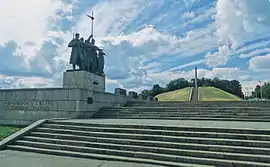
 Krasna Square and Shevchenko Theatre
Krasna Square and Shevchenko Theatre Monument to Hetman Mazepa by Giennadij Jerszow
Monument to Hetman Mazepa by Giennadij Jerszow Opera and Drama Theatre, designed by Semyon Fridlin
Opera and Drama Theatre, designed by Semyon Fridlin
.jpg.webp) Building of the Chernihiv Regional Youth Center (former Shchors theater)
Building of the Chernihiv Regional Youth Center (former Shchors theater) Hotel Desna
Hotel Desna
 Archbishop's residence
Archbishop's residence
 Mykhailo Kotsiubynskyi Museum
Mykhailo Kotsiubynskyi Museum House of Tarnovsky, now Museum of Antiquities
House of Tarnovsky, now Museum of Antiquities Church of Saint Michael and Saint Fedor in Chernihiv
Church of Saint Michael and Saint Fedor in Chernihiv.jpg.webp)
 Old and modern buildings
Old and modern buildings Central Post Office
Central Post Office

 New apartment block
New apartment block City hospital
City hospital


_-_1.jpg.webp)
.JPG.webp)

Honorary citizens
Notable people



- Vladimir Antonov-Ovseenko (1883–1938), Soviet Bolshevik leader and diplomat
- Vladyslav Atroshenko (born 1968) a Ukrainian politician and mayor of Chernihiv.
- Angelica Balabanoff (1878–1965) a Jewish Russian-Italian social democratic activist.
- Xenia Belmas (1890–1981) a Ukrainian soprano, doyenne of the Paris Opera
- Oleksandr Chemerov (born 1981) rock musician and frontman of rock band Dymna Sumish
- Stepan Davydov (1777–1825) an Imperial Russian composer and singer.
- Olga Della-Vos-Kardovskaya (1875–1952) a Russian painter and graphic artist.
- Nikolai Fedorovich Drozdov (1862–1953), scientist and Red Army general
- Alter Esselin (1889–1974) a Jewish-American poet who wrote in the Yiddish language.
- Haim Gamzu (1910–1982) an Israeli art and drama critic.
- Mordechai Hershman (1888–1940) an American Jewish cantor ("chazzan") and singer.
- Isaac of Chernigov (12th C.) a Jewish scholar on questions of Biblical exegesis
- Giennadij Jerszow (born 1967), Polish and Ukrainian sculptor and jewellery designer
- Yehuda L. Katzenelson (1846–1917) a military doctor, writer and publicist of Hebrew Literature.
- Anna Leporskaya (1900–1982), Soviet avant-garde artist
- Oleh Liashko (born 1972) a Ukrainian politician and journalist, leader of the Radical Party.
- Mykola Marchenko (born 1943) sculptor
- Anna Maximovitch (1901–1943) a Russian aristocrat and neuropsychiatrist
- Basile Maximovitch (1902–1944) Russian aristocrat, mining engineer and Soviet agent
- Zelda Mishkovsky (1914–1984), known as Zelda, an Israeli poet.
- Solomon Nikritin (1898–1965) a painter, avant-garde artist, philosopher and author.
- Alexander Ozersky (1813–1880) a noble Russian military geologist and governor of Tomsk.
- Anatoly Rybakov (1911–1998) Soviet and Ukrainian writer of novels and children books
- Valeria Shashenok (born 2001), Ukrainian photographer and 2022 war refugee
- Sviatoslav III of Kiev (1126–1194) ruled Kiev alongside Rurik Rostislavich
- Yulia Svyrydenko (born 1985) First Vice Prime Minister of Ukraine since November 2021.
- Jacob Tamarkin (1888–1945), Russian-American mathematician
- Dora Wasserman (1919–2003) a Jewish-Canadian actress, playwright and theatre director.
Sport
.jpg.webp)
- Oleksandr Batyuk (born 1960) cross-country skier, team silver medallist at the 1984 Winter Olympics
- Denys Bezborodko (born 1994), Ukrainian footballer with 200 club caps
- Yana Doroshenko (born 1994), Ukrainian-born Azerbaijani volleyball player
- Vitaliy Havrysh (born 1986) retired Ukrainian footballer with 400 club caps
- Yuriy Hruznov (born 1947), goalkeeper and coach, 116 club caps with FC Desna Chernihiv
- Tatiana Kostiuk (born 1982) French chess player and Woman chess Grandmaster.
- Alexander Kovchan (born 1983) a Ukrainian chess Grandmaster
- Tatiana Melamed (born 1974) German Woman chess grandmaster
- Dmytro Mytrofanov (born 1989) a Ukrainian middleweight professional boxer
- Andriy Protsko (born 1947), Ukrainian footballer, over 300 club caps for FC Desna Chernihiv
- Vladimir Savon (1940–2005) a Ukrainian chess player and Grandmaster.
- Yukhym Shkolnykov (1939–2009) Ukrainian coach and Soviet footballer.
- Eduard Weitz (born 1946), Israeli Olympic weightlifter
- Andriy Yarmolenko (born 1989), Ukrainian footballer with 350 club caps and 109 for Ukraine plays for West Ham
Twin towns – sister cities
Chernihiv is twinned with:[45]
 Gabrovo, Bulgaria
Gabrovo, Bulgaria Gomel, Belarus
Gomel, Belarus Hradec Králové, Czech Republic
Hradec Králové, Czech Republic Lappeenranta, Finland
Lappeenranta, Finland Memmingen, Germany
Memmingen, Germany Ogre, Latvia
Ogre, Latvia Petah Tikva, Israel
Petah Tikva, Israel Prilep, North Macedonia
Prilep, North Macedonia Rzeszów, Poland
Rzeszów, Poland Tarnobrzeg, Poland
Tarnobrzeg, Poland
Notes
- ↑ Russian: Чернигов, IPA: [tɕɪrˈnʲiɡəf]; Belarusian: Чарнігаў, romanized: Charnihaw, IPA: [t͡ʂarˈnʲiɣau̯]
References
- ↑ У в.о. мера Чернігова проводять обшуки
- ↑ Small biography on Oleksandr Lomako, Civil movement "Chesno" (in Ukrainian)
- ↑ "Чернігівська територіальна громада" (in Ukrainian). decentralization.gov.ua.
- ↑ Чисельність наявного населення України на 1 січня 2022 [Number of Present Population of Ukraine, as of January 1, 2022] (PDF) (in Ukrainian and English). Kyiv: State Statistics Service of Ukraine. Archived (PDF) from the original on 4 July 2022.
- ↑ "Zelensky gives the honorary title 'Hero City' to Kharkiv, Chernihiv, Mariupol, Kherson, Hostomel, and Volnovakha". Kyiv Independent. March 6, 2022. Retrieved April 21, 2022.
- ↑ "What does Chernyy mean". www.wordhippo.com. Retrieved 12 April 2022.
- ↑ "Chernikov". www.chernikov.com/. Retrieved 12 April 2022.
- ↑ Олександер, Мишанич (1989). Літопис Руський: За Іпатьским Списком Переклав Леогід Махимович (in Ukrainian). Київ: Дніпро. p. 18. ISBN 5308000522.
- ↑ Nasledie Svyatoy Rusi Archived 2018-04-02 at the Wayback Machine URL accessed on January 12, 2006
- ↑ "CHERNIGOV - JewishEncyclopedia.com". jewishencyclopedia.com.
- ↑ "Chernigov".
- ↑ "Gefängnis Cernihiv". Bundesarchiv.de (in German). Retrieved 26 February 2022.
- ↑ "Jüdisches Arbeitsbataillon Cernihiv". Bundesarchiv.de (in German). Retrieved 26 February 2022.
- ↑ ""Leninopad" continues – monuments dismantled in Dnipropetrovsk, Poltava and Chernihiv". Ukrainska Pravda. 2014-02-22.
- ↑ The monument of Lenin in Chernigov has fallen on YouTube
- ↑ "Про утворення та ліквідацію районів. Постанова Верховної Ради України № 807-ІХ". Голос України (in Ukrainian). 2020-07-18. Retrieved 2020-10-03.
- ↑ "Нові райони: карти + склад" (in Ukrainian). Міністерство розвитку громад та територій України. 17 July 2020.
- ↑ "Rzeszow Signs Partnership Agreement With Chernihiv | MENAFN.COM". menafn.com. Retrieved 2022-06-23.
- ↑ "Rzeszow signs partnership agreement with Chernihiv". www.ukrinform.net. 21 June 2022. Retrieved 2022-06-23.
- ↑ "Раньше всех. Ну почти". t.me. Retrieved 2022-02-25.
- ↑ Santora, Marc (2022-03-10). "What Happened on Day 15 of Russia's Invasion of Ukraine". The New York Times. ISSN 0362-4331. Retrieved 2022-03-18.
- ↑ Russian Military Leaves Chernihiv Region, Plants Mines In Many Areas - Governor Chaus, Ukrainian News Agency (5 April 2022)
- ↑ "10 найбільш зруйнованих міст України, серед яких і місто-герой – Чернігів (ВІДЕО)". 0462. 2022-05-03.
- ↑ "Три месяца войны России в Украине: главные события, фотографии и инфографика". BBC News | Русская служба. 2022-05-24.
- ↑ "Рідні мови в об'єднаних територіальних громадах України".
- ↑ Восьме всеукраїнське муніципальне опитування Квітень – Травень 2023
- ↑ Погода и Климат – Климат Чернигов [Weather and Climate – The Climate of Chernihiv] (in Russian). Weather and Climate (Погода и климат). Retrieved 29 October 2021.
- ↑ "World Meteorological Organization Climate Normals for 1981–2010". World Meteorological Organization. Archived from the original on 17 July 2021. Retrieved 17 July 2021.
- ↑ "Weatherbase: Historical Weather for Chernihiv, Ukraine". Weatherbase. Retrieved March 1, 2013.
- ↑ "Chernihiv Climate Normals 1991–2020". National Oceanic and Atmospheric Administration. Retrieved 1 November 2023.
- ↑ "Historic Centre of Tchernigov, 9th -13th centuries". UNESCO World Heritage Centre.
- ↑ Shaposhnikov, Denys (2023-01-26). "Історичний центр Чернігова подають до списку Світової спадщини ЮНЕСКО". Суспільне Новини (in Ukrainian). Retrieved 2023-11-22.
- ↑ "«Культурний ландшафт Чернігова»: чергова спроба включити до Списку всесвітньої спадщини ЮНЕСКО історичну частину міста". Чернігів Стародавній (in Ukrainian). 2023-05-16. Retrieved 2023-11-22.
- ↑ "КОМПАНІЯ "ЧЕКСІЛ"". wwww.chernigiv-rada.gov.ua. Retrieved 3 November 2020.
- ↑ "Collar". www.findtm.ru. Retrieved 2 January 2021.
- ↑ "ЮРИЙ СИНИЦА – ГЕНЕРАТОР ИДЕЙ". www.zoomir.ru. Retrieved 2 January 2021.
- ↑ "Yuri Sinitsa, the COLLAR Company owner, became one of the winners!". www.collarglobal.com. 10 July 2019. Retrieved 2 January 2021.
- ↑ "FC Desna Chernihiv qualified for the Europa League for the first time since 1960". thetimeshub.in. Archived from the original on 10 July 2020. Retrieved 9 July 2020.
- ↑ "FC Chernihiv". www.svoboda.fm. Retrieved 22 August 2020.
- ↑ "ФК Чернігів у новому сезоні зіграє у Першій лізі". www.sportarena.com. 12 August 2022. Retrieved 12 August 2022.
- ↑ "Чернігів у новому сезоні зіграє у Першій лізі". www.sport.ua. Retrieved 12 August 2022.
- ↑ "Jewish cemetery". www.esjf-surveys.org. Retrieved 19 November 2020.
- ↑ "Chernihiv". www.jewua.org. 10 April 2012. Retrieved 19 November 2020.
- ↑ "Chernigov Jewish cemetery". www.medium.com. 9 April 2018. Retrieved 19 November 2020.
- ↑ "Міста партнери міста Чернігова". chernigiv-rada.gov.ua (in Ukrainian). Chernihiv. Retrieved 2022-11-23.
Sources
- Ocherk istorii goroda Chernigova 907–1907 gg. (Chernihiv 1908)
- Hrushevs'kyi, M. (ed). Chernihiv i Pivnichne Livoberezhzhia (Kyiv 1928)
- Martin Dimnik. The Dynasty of Chernigov, 1146–1246.
- Rybakov, B. Drevnosti Chernigova (Moscow 1949)
- Ignatkin, I. Chernigov (Kyiv 1955)
- Iedomakha, I. Chernihiv (Kyiv 1958)
- Logvin, G.N. (Г. Н. Логвин) (1965). Chernigov, Novgorod-Seversky, Glukhov, Putivl (Чернигов, Новгород-Северский, Глухов, Путивль) (in Russian). Moscow.
- Asieiev, Iu. Arkhitektura Kyïvs'koï Rusi (Kyiv 1969)
- Karnabida, A. Chernihiv. Istorychno-arkhitekturnyi narys (Kyiv 1969)
- (1972) Історіа міст і сіл Української CCP – Чернігівська область (History of Towns and Villages of the Ukrainian SSR – Chernihiv Oblast), Kyiv. (in Ukrainian)
- Asieiev, Iu. Dzherela. Mystetstvo Kyïvs'koï Rusi (Kyiv 1980)
- Pyotr Rappoport (П. А. Раппопорт) (1993). Ancient Russian Architecture (Древнерусская архитектура) (in Russian). Saint-Petersburg.
External links
- Chernihiv City Portal
- chernigiv-rada.gov.ua — Official webportal of the Chernihiv City Rada (in Ukrainian and English)
- Chernihiv guide
- Chernihiv in the Encyclopedia of Ukraine
- "Chernigov-Gethsemane" Icon of the Mother of God. Russian Orthodox Cathedral of St. John the Baptist, Washington DC. (ROCOR).
- Chernihiv Sketch Map — Sketch Map of Chernihiv
- Chernihiv souvenirs — Chernihiv Gifts and Souvenirs
- History of Jewish Community in Chernigov
- The murder of the Jews of Chernihiv during World War II, at Yad Vashem website.


